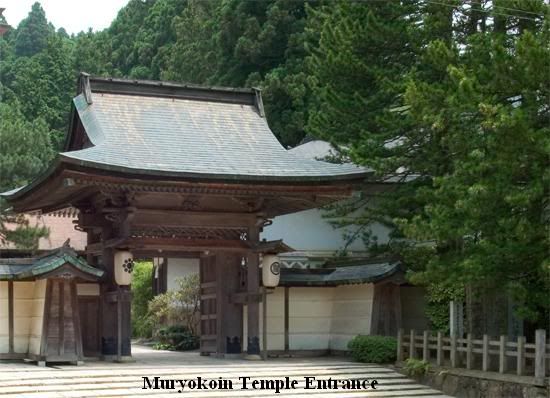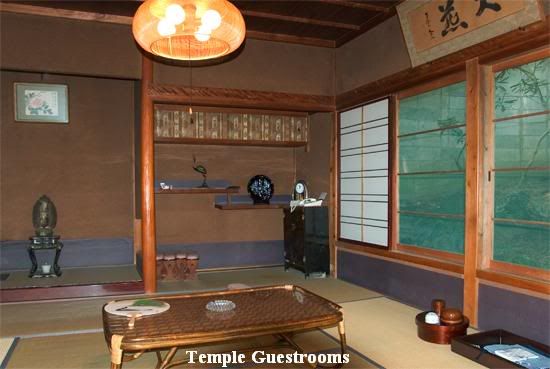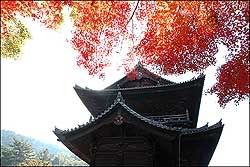Hướng về phương đông tầm cầu giác ngộ
by Ramsey Zarifeh, swissinfo, số ra ngày 01 Tháng 05, 2005
 Koyasan, Japan - Cao Dã Sơn (高野山),một thị trấn thiền môn nằm trên vùng núi ở độ cao 1000 mét so với mặt biển, thuộc phía Tây Nhật Bản, đã được xem là chốn thiêng liêng cho khách hành hương từ thế kỷ thứ tám. Ngày nay, nơi này là quê hương của Kurt Kubli, một tăng sĩ Thụy Sĩ, người đã rời bỏ quê mẹ ba thập niên trước để tầm cầu chân lý.
Koyasan, Japan - Cao Dã Sơn (高野山),một thị trấn thiền môn nằm trên vùng núi ở độ cao 1000 mét so với mặt biển, thuộc phía Tây Nhật Bản, đã được xem là chốn thiêng liêng cho khách hành hương từ thế kỷ thứ tám. Ngày nay, nơi này là quê hương của Kurt Kubli, một tăng sĩ Thụy Sĩ, người đã rời bỏ quê mẹ ba thập niên trước để tầm cầu chân lý.Cao Dã Sơn được khai phá 1,200 năm trước và là tổ đình của Phật Giáo Chân Ngôn Tông Nhật Bản. Hằng trăm tăng sĩ sinh sống và làm việc tại thị trấn, đường phố trong thị trấn nằm chen lẫn với những ngôi chùa cổ được xây dựng bằng gỗ. Không cần phải mất thời gian lâu dài để tìm kiếm một cư dân người Thụy Sĩ duy nhất cũng là một tăng sĩ nổi tiếng tại Cao Dã Sơn.
Nhân viên văn phòng du lịch hỏi tôi “ Bạn muốn tìm Kurt chăng? Chẳng có gì khó khăn cả, ở đây ông ấy nổi tiếng hơn cả Thống Ðốc tiểu bang Califonia, cựu diễn viên điện ảnh Arnold Schwarzenegger."
Kurt sinh ra ở Zurich, ông tới Nhật Bản vào năm 1980 và định cư tại Cao Dã Sơn với người vợ Nhật hồi 8 năm trước. Ngày nay, người ta biết ông với cái tên Kurto Gensou, là một trong số các tu sĩ tại chùa Vô Lượng Quang (Muryoko-in- 無量光院) một tự viện gần trung tâm thành phố.
 Khi được đưa đi dài theo hành lang đến một sảnh đường rộng rãi để ngồi chờ đợi ông ta, tôi không bắt gặp dấu hiệu nào cho thấy có sự hiện diện của một cư dân ngoại quốc tại Muryoko-in.
Khi được đưa đi dài theo hành lang đến một sảnh đường rộng rãi để ngồi chờ đợi ông ta, tôi không bắt gặp dấu hiệu nào cho thấy có sự hiện diện của một cư dân ngoại quốc tại Muryoko-in.Theo lời vị tri khách tăng, Kurt đang bận rộn đưa du khách viếng thăm quanh thị trấn và sẽ không trở về kịp cho đến khuya.
Tôi đang chuẩn bị ngả lưng một đêm trên sàn gỗ ở đấy thì có tiếng gõ cửa và khung cửa giấy được đẩy sang bên một cách êm thắm, một người đàn ông bước vào, người mà tôi đã du hành qua 6,000 dặm để gặp gỡ. Ông ta chào mừng tôi bằng tiếng Anh, tiếng Thụy Sĩ giọng Ðức và tiếng Nhật .
Trong buổi tối hôm ấy, Kurk kể tôi nghe cuộc đời ông trước khi đến Cao Dã Sơn với những giai đoạn từng là chủ ngân hàng, thương gia, họa gia, nhiếp ảnh gia và thiền sinh Yoga, v.vv... Ông nói ông chưa bao giờ cảm thấy Thụy sĩ là nhà mình và ông xác nhận ông đã làm đúng trong việc quyết định định cư tại Nhật Bản. Ông nói “ Tôi chẳng có điều gì vấn vương với quê hương Thụy Sĩ cả, tôi không ưa ngay cả phó mát, thức ăn mà người ta sống lớn lên với nó hằng ngày. Dĩ nhiên tôi vẫn giữ hộ chiếu Thụy Sĩ của tôi, đó là một tài liệu hay ho mà, nhưng trong tâm tưởng tôi, tôi là một công dân của thế giới”.
Ông nói:“Tôi thức dậy lúc 4 giờ và việc đầu tiên là pha một cốc trà xanh, trong cái tĩnh lặng của ban mai, ngay cả tiếng động nhỏ nhất của nước trà rót vào trong cốc cũng trở thành âm nhạc”, rồi ông kể lể tiếp “hằng trăm hoặc hàng ngàn” câu chú nguyện khác nhau trước khi tham gia vào khóa công phu tụng niệm buổi sớm.
Ông Kurt dùng thời giờ vào việc hướng dẫn du khách tham quan quanh khu vực Cao Dã Sơn và tra cứu tài liệu để viết một quyển sách mà ông dự định sẽ xuất bản vào cuối năm nay bằng ba ngôn ngữ. Nhưng ông từ chối đề nghị trở thành một thứ đại sứ quốc tế đại diện thị trấn thiền môn Cao Dã Sơn này.
“Tôi chẳng muốn … gán cho mình một cái danh hiệu như thế, đặc biệt là người Thụy Sĩ chúng tôi rất khiêm nhường, có lẽ nên gọi tôi là một nhà sư gàn dở thì dễ dàng nhất” .
Tiếng tăm của Kurt vang dội khắp đường phố Cao Dã Sơn. Ðài truyền hình, hãng điện ảnh Nhật Bản và ngoại quốc đã phát hành một số phim tài liệu về ông, nên việc xuất hiện trên đường phố mà không có người nhận ra ông thật là một điều hiếm hoi.
Trong lúc ông bận rội với một nhóm du khách Hoa Kỳ ở quanh chùa, tôi hỏi một pháp lữ của ông rằng người ta nghĩ thế nào về ông tại địa phương này.
“Ông ấy không thích ứng với bất cứ phạm trù nào, mà anh cũng không thể liệt ông ấy vào loại người gì cả, ông ta là một cá thể độc nhất”.
Ông nhận lời để cho tôi phỏng vấn trong hai giờ về con đường đưa đến giác ngộ mà ông đã trải qua.Sáng hôm sau, lúc tiếng cồng vang lên bên tai tôi vào khoảng 6 giờ kém thì ông bước vào với thái độ hơi gấp rút, ông cho tôi biết chuyến tàu hỏa mà tôi phải lên để rời khỏi Cao Dã Sơn sẽ khởi hành trong vòng 20 phút. Ông kêu gọi một vài tu sĩ khác giúp tôi thu nhặt gói ghém hành lý và đẩy tôi lên chiếc xe đang chờ đợi bên ngoài.
Máy xe đang nổ nhưng nhiệt độ xuống thấp tối đêm qua đã đóng một lớp đá trên mặt đất và trên kính gió xe. Tôi quay sang định hỏi ông liệu chúng ta có bị trễ chuyến tàu hỏa không thì thấy ông phóng ra từ nhà bếp với một chiếc ấm đồng to tướng. Lớp đá trên mặt kính chảy ra lập tức, với đôi guốc gỗ và bộ đồ mặc trong buổi công phu, ông nhảy lên ghế tài xế và đóng sầm cửa lại.
“Sẽ vất vả lắm đấy, nhưng anh sẽ đến đúng giờ”, ông nói một cách chắc nịch.
Có thể ông phải du hành sang phía bên kia thế giới để tìm kiếm một thiên đường mà thời gian không hạn cuộc, nhưng, khi phải …chạy đua với thời gian, Kurt vẫn là một người Thụy Sĩ như ông đã từng là.
http://www.muryokoin.org/
Hạt Cát lược dịch
Heading east in search of enlightenment
by Ramsey Zarifeh, swissinfo, May 1, 2005
 Koyasan, Japan -- Koyasan, a temple town perched 1,000 metres above sea level in the mountains of western Japan, has been a place of pilgrimage since the eighth century. Today it is the home of Kurt Kübli, a Swiss monk who left his homeland three decades ago in search of spiritual enlightenment.
Koyasan, Japan -- Koyasan, a temple town perched 1,000 metres above sea level in the mountains of western Japan, has been a place of pilgrimage since the eighth century. Today it is the home of Kurt Kübli, a Swiss monk who left his homeland three decades ago in search of spiritual enlightenment.Koyasan was founded 1,200 years ago and is the headquarters of the Shingon Buddhist order. Hundreds of monks live and work in the town, the streets of which are lined with ancient wooden temples.
It doesn't take long to track down Koyasan's only Swiss resident and by far and away the most famous monk in town.
"You want to meet Kurt?" asks the man at Koyasan's tourist office. "That won't be difficult. He's more famous here than Arnold Schwarzenegger."
Kurt was born in Zurich, first visited Japan in 1980 and settled in Koyasan with his Japanese wife eight years ago.
Today he goes by the name of Kurto Gensou and is one of the monks at Muryoko-in, a temple close to the centre of town.
Meeting a monk
There is no sign of Muryoko-in's resident foreigner when I am ushered along the temple's creaking wooden corridor and told to wait in a large room overlooking an immaculately kept rock garden.
According to the monk who serves me dinner - a wholesome vegetarian meal prepared in the temple kitchen ? Kurt is busy showing visitors around the town and will not be back until after dark.
I am about to settle down on the tatami floor for the night when there is a loud knock. The paper-screen door slides silently open and in walks the man whom I have travelled 6,000 miles to meet. He greets me in English, Swiss-German and Japanese.
"Come on, I'll show you the local bar," he says. "And if you're interested, I'll tell you my life story".
Of all the images of Kurt I could have imagined, none was as a local sitting at the corner table of the only pub in town.
But over a series of beers and cups of warm m>sakém> he explains that monks on Koyasan are not obliged or even expected to lead solitary existences.
"We don't stay shut up all day in the temples. And when we drink alcohol, it is not to get drunk but to relax and talk to people," says Kurt, who once worked as a wine merchant in Switzerland.
"This pub is the best place to find out what's going on and a little bit of saké helps make the conversation flow."
Previous life
During the course of the evening, Kurt offers hints about his life before Koyasan, which included stints as a banker, businessman, contemporary artist, photographer and student of yoga and flamenco.
He says he never felt at home in Switzerland and is convinced he made the right decision to settle in Japan.
"I don't hold any particular affection for my home country. I don't even really like cheese, which is something you grow up with there.
"Of course I still have my Swiss passport, which is a very beautiful document. But in my heart, I am a citizen of the world."
There is little time to learn more about Kurt's formative years in Switzerland, as he has to return to his small room in the temple and prepare for an early start.
"I get up every day at 4am and the first thing I do is make a cup of green tea. In the silence of the morning, even the smallest sound of pouring tea into a cup becomes music," he says.
He then recites "many hundreds or thousands" of different mantras before leading or joining in chanting and singing at the temple's early-morning ceremony.
Celebrity status
Kurt spends his days showing foreign visitors around Koyasan and researching a book on the main temple complex which he plans to publish in three languages later this year.
But he rejects the suggestion that he has become an international ambassador for the temple town.
"I wouldn't want to give myself such a title, especially because we Swiss tend to be very modest. Maybe the easiest way of referring to me is as the 'crazy monk'."
Kurt's celebrity status is not confined to the streets of Koyasan. Japanese and foreign film and television crews have produced documentaries on him and he says he is unable to walk around many cities in Japan without being recognised.
While Kurt is out showing a group of American tourists around the temple precincts, I ask some of his colleagues at Muryoko-in what the locals make of him.
"He doesn't fit into any particular category," says one. "And you can't pigeonhole him in any way. He's just a unique character."
As if to prove the point, Kurt later responds to my attempts to interview him about the path to enlightenment by signing me up for a two-hour Thai massage at a nearby temple.
"The massage may be painful, but it is very good for re-energising the body and mind," he assures me.
Rude awakening
Next morning, the temple gong rings in my ears shortly before 6am. Kurt slides open the door in a mild panic to inform me that my train leaves in less than 20 minutes.
He summons several monks to help gather up my belongings and bundle them and me into the waiting temple car.
The engine is running, but the temperature has fallen overnight, thick snow covers the ground and the windscreen is hidden under a layer of unbreakable ice.
As I turn to ask Kurt if we are going to miss the train, he darts out of the temple kitchen clutching an enormous copper kettle.
The scalding contents are emptied over the glass, the ice melts in an instant and Kurt ? clad in wooden clogs and ceremonial robes ? jumps in the driver's seat and slams the door.
"It'll be tight, but you'll be on time," he says accurately.
He may have travelled to the other side of the world in search of a timeless paradise. But when it comes to precise timekeeping, Kurt remains as Swiss as they get.
http://www.buddhistchannel.tv/index.php?id=9,1111,0,0,1,0
0 Comments:
Đăng nhận xét
<< Home